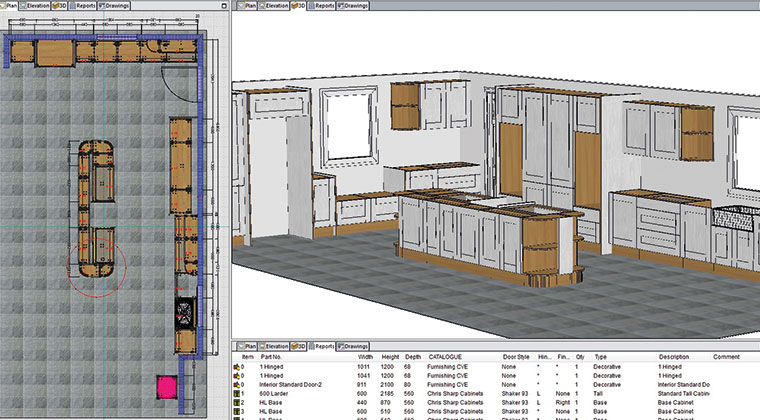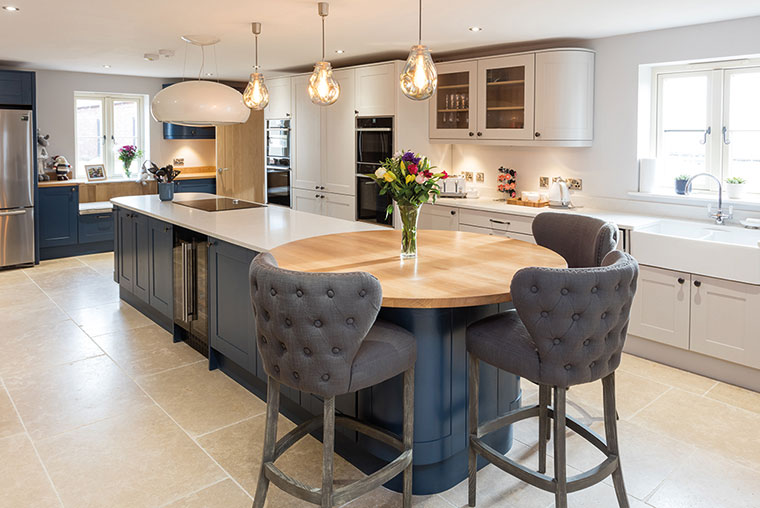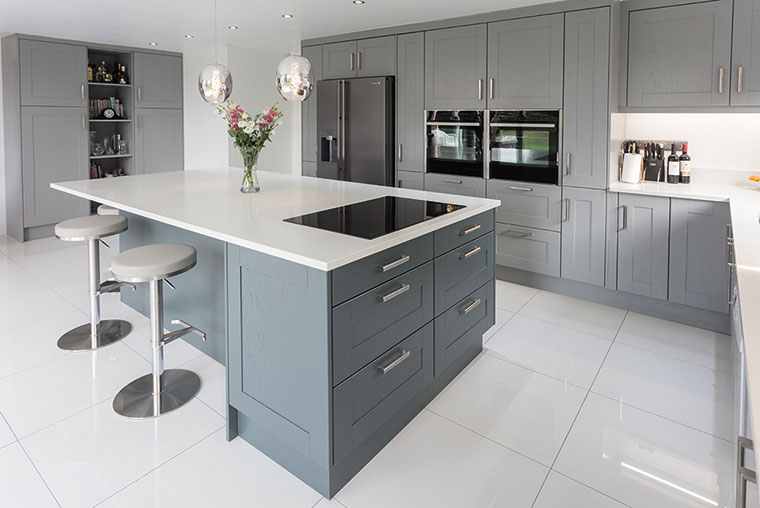Stage one – designing a 20-unit kitchen for a developer took a matter of minutes with Cabinet Vision. Stage two – the material was ordered at 4.55pm the same day. Stage three – the following day it was cut, drilled, edged, assembled and delivered by 12.30pm. According to Paul Kettleborough, MD and owner of Chris Sharp Cabinets, Alphacam’s Cabinet Vision software has radically streamlined kitchen production in his business, and has created so much more potential …
“I did that simply to prove a point,” says Paul Kettleborough. “I wanted to know just how quickly we could produce a kitchen. Although we had to machine multiple panels, our CNC machine was running at up to 80m a minute.”

Chris Sharp Cabinets’ Paul Kettleborough and James Graves
Employing a dozen people at its 15,000 sq ft workshop and showroom in Lincolnshire, the company generally produces two kitchens a week for end-users, with a number of others for property developers. Having recently invested in Cabinet Vision software to complement its Alphacam package, the business has capacity for designing and manufacturing around 20 a week.
With a long-standing history of making both softwood and hardwood furniture, the company decided it needed to diversify as cheap imports began to have an effect on business, and moved into the purely bespoke kitchen market. Three years ago, having worked there for over 20 years, Paul bought the company from Chris Sharp, and decided to concentrate solely on kitchens.

Chris Sharp Cabinets can now complete a full kitchen plan in around 20 minutes
Alphacam had been the main software for furniture production there for many years, and the company continued to use it to design and manufacture the cabinetry components for its kitchens – Paul admits that it was not the optimum tool for casework assemblies.
“It was taking a long time to programme our three-axis SCM Ergon machine tool,” he says. “We’d have a standard 600mm base unit with the holes and toolpaths – but if a customer wanted a 550mm unit, for example, I’d have to take it down by 50mm.
“So, in time, my Alphacam program had up to 150 different units. And if a kitchen contained 600, 500 and 400mm units, I’d put them on a separate sheet and nest them through Alphacam, which was a long-winded process when compared to Cabinet Vision, because it’s not optimised for that type of work.”
So, the natural progression was to invest in Cabinet Vision for carcass work. Design manager James Graves now receives each customer order as an ArtiCAD drawing from its external designer, and imports it into Cabinet Vision.
“As I’ve got a library of the 60 or so cabinets that we use regularly, I create the rooms by dragging and dropping the units into the project, and then editing them. The ArtiCAD file is often just a plan with dimensions on, usually in increments of 50, but with Cabinet Vision’s parametric capability and the parameters already set up, if I drop a 600mm unit in and change it to 587mm, all the relevant sizes and joins are all changed accordingly. Each one literally takes just seconds, and I can complete a full kitchen plan in around 20 minutes.”

Chris Sharp Cabinets moved into the bespoke kitchen market in response to the rise of cheap imported furniture
Being able to customise each unit is particularly valuable when he is working with the company’s handle-less cabinets. “We prefer to have these carcass-pressed, so we can choose that the jointing technique is all dowelled rather than KD-fitted. However, I can have KD fittings if required, and I have full control over their location and orientation. I can make all fittings on shelves up to a certain height face down, and the ones above it face up, so when the customer looks at it they don’t see where the fixing joints are.”
Cabinet Vision’s powerful communication tool, with the CNC nesting machine, S2M (Screen-To-Machine), sends the NC code to the Ergon, which includes all the cutting and drilling instructions for the machine.
Alphacam comes into play with the handle-less units, notching out the areas on the side of the panels for the profile to fit into, by sending machining code to the company’s Homag Weeke CNC.
Paul explains that this operation cannot be performed on the Ergon. “As it’s notched out, we wouldn’t be able to put the panel through the linear movement on an edgebander,” he says, “it just wouldn’t accept it. So we put it through as a rectangular piece which gets edgebanded on one edge, and as it’s neatly notched out for the profile on the Homag, the edgeband stays intact.
“Alphacam is also used to produce any curved, complex shape and hardwood doors. All these programs are done solely with it.”
And Alphacam also indirectly drives a Koch machine tool, by working in tandem with Cabinet Vision.

Chris Sharp Cabinets receives each customer order as an ArtiCAD drawing and imports it into Cabinet Vision
“As the Cabinet Vision files go to S2M, it stores the programs in Alphacam, along with the position of the holes that need to be drilled horizontally. All holes – both on the main faces of the panels and the edges – are designed and placed there by Cabinet Vision.
“I pull up the nested program in Alphacam, and those on the face are drilled by the Ergon. But I can also get the same file in a different format, which gives the hole sequence for that individual panel, and the horizontal holes are drilled on the Koch.”
Concluding, James Graves says another advantage of using Cabinet Vision is that it means the company can give an accurate price for the job.
“All materials and their price are in the system, so I can see at a glance how much each unit costs, and the price for the whole kitchen, right down to the screws. We can come in with a bottom-line figure to stay competitive. It’s a bespoke kitchen, but not a bespoke price.”









